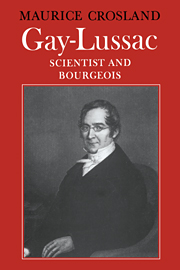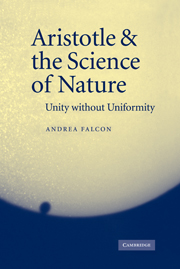Refine search
Actions for selected content:
10306 results in History of science: general interest
Patricia Fara, Science: A Four Thousand Year History. Oxford: Oxford University Press, 2009. Pp. xv+408. ISBN 978-0-19-922689-4. £20.00 (hardback).
-
- Journal:
- The British Journal for the History of Science / Volume 42 / Issue 4 / December 2009
- Published online by Cambridge University Press:
- 26 November 2009, pp. 613-615
- Print publication:
- December 2009
-
- Article
- Export citation
Index of authors
-
- Journal:
- The British Journal for the History of Science / Volume 42 / Issue 4 / December 2009
- Published online by Cambridge University Press:
- 26 November 2009, p. 639
- Print publication:
- December 2009
-
- Article
- Export citation
Jean A. Givens, Karen M. Reeds and Alain Touwaide (eds.), Visualizing Medieval Medicine and Natural History, 1200–1550. AVISTA Studies in the History of Medieval Technology, Science and Art. Aldershot: Ashgate, 2006. Pp. xx+278. ISBN 0-7546-5296-3. £55.00 (hardback).
-
- Journal:
- The British Journal for the History of Science / Volume 42 / Issue 4 / December 2009
- Published online by Cambridge University Press:
- 26 November 2009, pp. 602-603
- Print publication:
- December 2009
-
- Article
- Export citation
Robert N. Proctor and Londa Schiebinger (eds.), Agnotology: The Making and Unmaking of Ignorance. Stanford: Stanford University Press, 2008. Pp. viii+298. ISBN 978-0-8047-5901-4. $24.95 (paperback).
-
- Journal:
- The British Journal for the History of Science / Volume 42 / Issue 4 / December 2009
- Published online by Cambridge University Press:
- 26 November 2009, pp. 615-616
- Print publication:
- December 2009
-
- Article
- Export citation
Books reviewed
-
- Journal:
- The British Journal for the History of Science / Volume 42 / Issue 4 / December 2009
- Published online by Cambridge University Press:
- 26 November 2009, pp. 641-644
- Print publication:
- December 2009
-
- Article
- Export citation
Deborah Coen, Vienna in the Age of Uncertainty: Science, Liberalism, and Private Life. Chicago and London: University of Chicago Press, 2007. Pp. xi+380. ISBN 978-0-226-11172-8. $45.00, £28.50 (hardback).
-
- Journal:
- The British Journal for the History of Science / Volume 42 / Issue 4 / December 2009
- Published online by Cambridge University Press:
- 26 November 2009, pp. 624-626
- Print publication:
- December 2009
-
- Article
- Export citation
Joseph E. Harmon and Alan G. Gross (eds.), The Scientific Literature: A Guided Tour. Chicago and London: University of Chicago Press, 2007. Pp. xxiv+327. ISBN 978-0-22631656-7. $72.50, £46.00 (hardback). ISBN 978-0-226-31656-7. $29.00, £18.50 (paperback).
-
- Journal:
- The British Journal for the History of Science / Volume 42 / Issue 4 / December 2009
- Published online by Cambridge University Press:
- 26 November 2009, pp. 612-613
- Print publication:
- December 2009
-
- Article
- Export citation
Mike Fortun, Promising Genomics: Iceland and deCODE Genetics in a World of Speculation. Berkeley: University of California Press, 2008. Pp. x+330. ISBN 978-0-520-24751-2. £17.95 (paperback).
-
- Journal:
- The British Journal for the History of Science / Volume 42 / Issue 4 / December 2009
- Published online by Cambridge University Press:
- 26 November 2009, pp. 631-632
- Print publication:
- December 2009
-
- Article
- Export citation
Horst Bredekamp, Birgit Schneider and Vera Dünkel (eds.), Das technische Bild. Kompendium zu einer Stilgeschichte wissenschaftlicher Bilder. Berlin: Akademie Verlag2008. Pp. 231. ISBN 978-3-05-004496-5. €29.80 (paperback).
-
- Journal:
- The British Journal for the History of Science / Volume 42 / Issue 4 / December 2009
- Published online by Cambridge University Press:
- 26 November 2009, pp. 611-612
- Print publication:
- December 2009
-
- Article
- Export citation
Cristina Grasseni (ed.), Skilled Visions: Between Apprenticeship and Standards. New York and Oxford: Berghahn, 2007. Pp. viii+226. ISBN 978-1845-45210-0. £45.00 (hardback).
-
- Journal:
- The British Journal for the History of Science / Volume 42 / Issue 4 / December 2009
- Published online by Cambridge University Press:
- 26 November 2009, pp. 604-606
- Print publication:
- December 2009
-
- Article
- Export citation
David Edgerton, Warfare State: Britain, 1920–1970. Cambridge: Cambridge University Press, 2005. Pp. xv+364. ISBN 0-521-67231-7. £45.00, $75.00 (paperback).
-
- Journal:
- The British Journal for the History of Science / Volume 42 / Issue 4 / December 2009
- Published online by Cambridge University Press:
- 26 November 2009, pp. 628-629
- Print publication:
- December 2009
-
- Article
- Export citation
Hannah Gay, The History of Imperial College London, 1907–2007: Higher Education and Research in Science, Technology and Medicine. London: Imperial College Press, 2007. pp. xxvii+825. ISBN 1-86094-709-3. £122.40, $152.00 (softcover).
-
- Journal:
- The British Journal for the History of Science / Volume 42 / Issue 4 / December 2009
- Published online by Cambridge University Press:
- 26 November 2009, pp. 630-631
- Print publication:
- December 2009
-
- Article
- Export citation
Alix Cooper, Inventing the Indigenous: Local Knowledge and Natural History in Early Modern Europe. Cambridge: Cambridge University Press, 2007. Pp. xiii+218. ISBN 978-0-521-87087-0. £45.00, $75.00 (hardback).
-
- Journal:
- The British Journal for the History of Science / Volume 42 / Issue 4 / December 2009
- Published online by Cambridge University Press:
- 26 November 2009, pp. 617-619
- Print publication:
- December 2009
-
- Article
- Export citation
David Stack, Queen Victoria's Skull: George Combe and the Mid-Victorian Mind. London: Hambledon Continuum, 2008. Pp. xviii+350. ISBN 978 1 84725 233 3.
-
- Journal:
- The British Journal for the History of Science / Volume 42 / Issue 4 / December 2009
- Published online by Cambridge University Press:
- 26 November 2009, pp. 620-621
- Print publication:
- December 2009
-
- Article
- Export citation
Giving wings to logic: Mary Everest Boole's propagation and fulfilment of a legacy
-
- Journal:
- The British Journal for the History of Science / Volume 43 / Issue 1 / March 2010
- Published online by Cambridge University Press:
- 11 November 2009, pp. 49-74
- Print publication:
- March 2010
-
- Article
-
- You have access
- HTML
- Export citation

Gay-Lussac
- Scientist and Bourgeois
-
- Published online:
- 03 November 2009
- Print publication:
- 23 November 1978

Evolution
- Selected Letters of Charles Darwin 1860–1870
-
- Published online:
- 16 October 2009
- Print publication:
- 24 April 2008
Architects of Armageddon: the Home Office Scientific Advisers' Branch and civil defence in Britain, 1945–68†
-
- Journal:
- The British Journal for the History of Science / Volume 43 / Issue 2 / June 2010
- Published online by Cambridge University Press:
- 08 October 2009, pp. 149-180
- Print publication:
- June 2010
-
- Article
- Export citation
Conjectures and reputations: The composition and reception of James Bradley's paper on the aberration of light with some reference to a third unpublished version
-
- Journal:
- The British Journal for the History of Science / Volume 43 / Issue 1 / March 2010
- Published online by Cambridge University Press:
- 24 September 2009, pp. 19-48
- Print publication:
- March 2010
-
- Article
- Export citation

Aristotle and the Science of Nature
- Unity without Uniformity
-
- Published online:
- 22 September 2009
- Print publication:
- 08 September 2005
